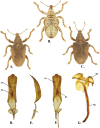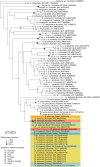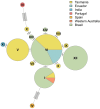Observations on iNaturalist reveal the establishment of non-native Eucalyptus weevil Gonipterus platensis (Coleoptera: Curculionidae) in Tamil Nadu, India
- PMID: 40278046
- PMCID: PMC12023155
- DOI: 10.1093/jisesa/ieaf029
Observations on iNaturalist reveal the establishment of non-native Eucalyptus weevil Gonipterus platensis (Coleoptera: Curculionidae) in Tamil Nadu, India
Abstract
We report the establishment of the invasive eucalyptus weevil Gonipterus platensis in the high elevation Nilgiri Plateau in the state of Tamil Nadu, India. Its presence was first brought to light by observations uploaded on iNaturalist, a citizen science platform, from Eucalyptus globulus plantations. Specimens collected from the plantations were examined morphologically and dissected to reveal the diagnostic characters of G. platensis. DNA sequences of the cytochrome c oxidase gene (COI) amplified from Indian specimens were 0.3% different from G. platensis sequences from Tasmanian populations and over 4% different from any other Gonipterus species for which DNA data are available. Sequence data from 6 invasive populations of G. platensis indicates multiple, independent invasions from a Tasmanian source population to different parts of the world. The collection of specimens, including larvae, over multiple years indicates that the population in the Nilgiris is persistent, with the earliest evidence for its presence in the region being March 2019. We recommend further monitoring and assessment of population growth and spread of Gonipterus platensis to minimize the economic impact of this potentially important pest of Eucalyptus in India. Citizen science played a critical role in this discovery, and we recommend that subject experts engage with nature enthusiasts on platforms like iNaturalist so that the wide reach of public participation is harnessed to effectively monitor biodiversity.
Keywords: Eucalyptus globulus; Nilgiris; biosystematics; citizen science; invasive; molecular identification.
© The Author(s) 2025. Published by Oxford University Press on behalf of Entomological Society of America.
Figures







References
-
- Ayuga-Téllez E, García-Iruela A, Rielo JC, et al.2022. Actions for monitoring the Gonipterus pest in Eucalyptus on the Cantabrian coast. Agronomy 12:1–18. https://doi.org/10.3390/agronomy12071692 - DOI
-
- Barratt BIP, Cock MJW, Oberprieler RG.. 2018. Weevils as targets for biological control, and the importance of taxonomy and phylogeny for efficacy and biosafety. Diversity 10:73–19. https://doi.org/10.3390/d10030073 - DOI
-
- Bennett BM. 2010. The El dorado of forestry: the eucalyptus in India, South Africa and Thailand. Int. Rev. Soc. Hist. 55:27–50. https://doi.org/10.1017/s0020859010000489 - DOI
-
- Bennett BM. 2014. The origins of timber plantations in India. Agric. Hist. Rev. 62:98–118.
-
- Branco S, Mateus EP, Gomes da Silva MDR, et al.2019. Electrophysiological and behavioural responses of the Eucalyptus weevil, Gonipterus platensis, to host plant volatiles. J. Pest Sci. 92:221–235. https://doi.org/10.1007/s10340-018-1055-0 - DOI
MeSH terms
Substances
LinkOut - more resources
Full Text Sources

